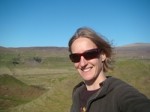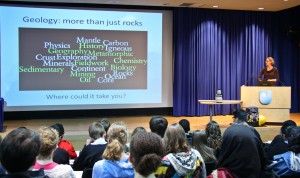A day in the life of a field geologist
Earth Scientists like me study the Earth: how it formed, how it changed over geological time, and how all the different ‘bits’ such as the atmosphere, oceans, soil and rocks interact with each other.
In detail, I’m a geologist – I specifically try to understand the rocks beneath our feet. And in even more detail, I’m a field geologist. Nothing excites me more than the prospect of getting to spend weeks in a tent up a remote mountain somewhere (although preferably not in the rain), collecting rock samples for analysis back in the lab.
Towards the end of 2013 I was asked to give a 10 minute talk to secondary-level school students, as part of the Open University Science Faculty’s annual schools lecture. This year was slightly different to previous years – four mini-talks instead of one hour-long one, and given by a spectrum of scientists that reflect the science community here at the OU, rather than some beardy old prof.
I decided to concentrate my talk on why scientists like me choose to head off into the wilds to collect samples, the kind of data that we are gathering, how we collect those data and what the rocks tell us about tectonic processes. You can see my talk by playing the embedded video below and read the abstract below that.
Abstract
Sweat, mud and leeches: A day in the life of a geologist in the Himalayas
Dr Clare Warren, Senior Research Fellow, The Open University
Geologists study rocks and fossils in order to understand how the Earth formed 4.5 billion years ago, and how the continents and oceans have changed since then. I’m particularly interested in mountains. Mountains form where two tectonic plates collide into each other (slowly!), and their rise and eventual erosion affects where geological processes such as volcanic eruptions, earthquakes, landslides and even long-term climate change happen.
In order to understand how (and how quickly) mountains grow and eventually erode, geologists do fieldwork in mountainous areas. We collect rock samples to figure out which rock types appear in different areas. Much of this aspect of my research takes place in the Himalayas. This talk described a whistle-stop tour of a typical geologist’s day in the Himalayan mountains in Bhutan – the delights of camping, the local food, the work and the fun.
The OU’s Himalayan-Tibet Research Group
When I’m not giving talks like this my research centres around the evolution of mountain belts formed when continents collide, and in particular the burial and exhumation history of high grade metamorphic rocks. I work closely with the Ar/Ar Research Group and the Himalayan-Tibet Research Group.
For more information about my research and other things I get up to, please visit the Himalaya-Tibet Research Group website.
And our YouTube channel with some fun movies shot on location in Bhutan.
I am always interested in hearing from potential students and postdocs who want to come and work in metamorphic, geochronological and tectonics research at the Open University.
If you’re interested, please send me an email.




Pingback: Plan for diversity and inclusion | Engaging Research